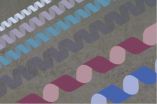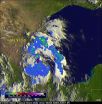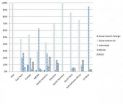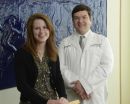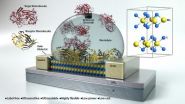(Press-News.org) Materials made from nanoparticles hold promise for myriad applications, from improved solar energy production to perfect touch screens. The challenge in creating these wonder-materials is organizing the nanoparticles into orderly arrangements.
Nanoparticles of magnetite, the most abundant magnetic material on earth, are found in living organisms from bacteria to birds. Nanocrystals of magnetite self-assemble into fine compass needles in the organism that help it to navigate.
Collaborating with nanochemists led by Rafal Klajn at the Weizmann Institute of Science in Israel, who found that magnetite nanocubes can self-assemble into helical superstructures under certain conditions, University of Illinois at Chicago theoretical chemist Petr Kral and his students simulated the phenomenon and explained the conditions under which it can occur. The joint study is online in Science Express in advance of print in the Sept. 5 issue of Science.
The Weizmann researchers dissolved the nanocrystals and exposed the solution to an external magnetic field. As the solution evaporated, helical chains of nanoparticles formed. Surprisingly, the spiral helices were chiral -- that is, either left- or right-handed -- despite the fact that the nanoparticles themselves are not chiral. Densely packed assemblies of helices tended to adopt the same handedness.
Kral's UIC team modeled the self-assembly to determine how helices formed in their collaborators' experiments -- and why the helices had chirality.
They found that the self-assembly into chiral helices is the result of the competing forces acting on them — Zeeman force from the external magnetic field, dipole-dipole magnetic force, magneto-anisotropic directional force, weakly attractive van der Waals forces, and others. The chemistry of the nanoparticle ligands, the solvent, and temperature may also play a role.
In the presence of an external magnetic field, the superparamagnetic nanocubes — which are randomly magnetic and can flip with temperature changes — became tiny magnets with different symmetries of the competing forces acting between them. As a result, when two cubes are face-to-face, they tend to tilt with respect to each other, forming a small angle to the right or left — the seed of a chiral helix, as more nanocubes line up with the first two.
Kral's analysis used a Monte Carlo computer algorithm, which relies on repeated random sampling, running simulations many times over.
"We had to write a new, efficient Monte Carlo computer code describing all the necessary terms, all the values, and then explain how the highly unusual behavior that Klajn observed – the helices' self-assembly – happens," Kral said.
INFORMATION:
Gurvinder Singh of the Weizmann Institute is first author of the paper. Elijah Gelman of the Weizmann Institute, and Henry Chan, Artem Baskin and Nikita Repnin of UIC are co-authors on the study.
The work was supported by the Israel Science Foundation grant 1463/11, the G. M. J. Schmidt-Minerva Center for Supramolecular Architectures, the Minerva Foundation with funding from the Federal German Ministry for Education and Research, National Science Foundation Division of Materials Research grant 1309765 and the American Chemical Society Petroleum Research Fund grant 53062-ND6.
Magnetic nanocubes self-assemble into helical superstructures
2014-09-05
ELSE PRESS RELEASES FROM THIS DATE:
A lifetime of outdoor activity may contribute to common eye disease; sunglasses may help
2014-09-04
BOSTON (Sept. 4, 2014) — Residential geography, time spent in the sun, and whether or not sunglasses are worn may help explain why some people develop exfoliation syndrome (XFS), an eye condition that is a leading cause of secondary open-angle glaucoma and can lead to an increased risk of cataract and cataract surgery complications, according to a study published on Sept. 4 in JAMA, Ophthalmology.
Despite improvements in understanding the cause of this common yet life-altering condition, more work needs to be done. "The discovery that common genetic variants in the lysyl ...
NASA sees Dolly's remnants bringing showers to the Rio Grande Valley
2014-09-04
Tropical Storm Dolly fizzled out quickly on September 3 after making landfall in eastern Mexico, and NASA's Aqua satellite saw some of the remnants moving into southern Texas. NASA's TRMM satellite analyzed the rainfall occurring in the storm as it was approaching landfall.
NASA's Aqua satellite captured the remnants of Tropical Depression Dolly over northeastern Mexico on Sept. 3 at 19:40 UTC (3:40 p.m. EDT). The image, captured by the Moderate Resolution Imaging Spectroradiometer or MODIS instrument showed the center of Dolly over northeastern Mexico with a band of thunderstorms ...
Hurricane Norbert pinwheels in NASA satellite imagery
2014-09-04
The Eastern Pacific's Hurricane Norbert resembled a pinwheel in an image from NASA's Terra satellite as bands of thunderstorms spiraled into the center. NASA's Global Precipitation Measurement or GPM mission has helped forecasters see that Norbert has lost some of its organization early on September 4.
The MODIS instrument or Moderate Resolution Imaging Spectroradiometer aboard NASA's Terra satellite captured a visible picture of Tropical Storm Norbert on Sept. 4 at 2:15 p.m. EDT when it resembled a pinwheel. The western bands of Norbert were moving over Socorro Island, ...
Climate-smart agriculture requires three-pronged global research agenda
2014-09-04
Faced with climate change and diminishing opportunities to expand productive agricultural acreage, the world needs to invest in a global research agenda addressing farm and food systems, landscape and regional issues and institutional and policy matters if it is to meet the growing worldwide demand for food, fiber and fuel, suggests an international team of researchers.
In a paper appearing online in the journal Agriculture and Food Security, the authors summarize the findings of the second international Climate Smart Agriculture conference held in March 2013 at UC Davis.
"Climate-smart ...
News media losing role as gatekeepers to new 'social mediators' on Twitter, study finds
2014-09-04
The U.S. government is doing a better job of communicating on Twitter with people in sensitive areas like the Middle East and North Africa without the participation of media organizations, according to a study co-authored by a University of Georgia researcher.
The study looked at the U.S. State Department's use of social media and identified key actors who drive its messages to audiences around the world. In particular, it examined the role played by news media and the government in bridging the State Department communication with people domestically and internationally. ...
Scientists identify rare stem cells that hold potential for infertility treatments
2014-09-04
DALLAS – Sept. 4, 2014 – Rare stem cells in testis that produce a biomarker protein called PAX7 help give rise to new sperm cells — and may hold a key to restoring fertility, research by scientists at UT Southwestern Medical Center suggests.
Researchers studying infertility in mouse models found that, unlike similar types of cells that develop into sperm, the stem cells that express PAX7 can survive treatment with toxic drugs and radiation. If the findings hold true in people, they eventually could lead to new strategies to restore or protect fertility in men undergoing ...
Sugar substitutes not so super sweet after all
2014-09-04
The taste of common sugar substitutes is often described as being much more intense than sugar, but participants in a recent study indicated that these non-nutritive sugar substitutes are no sweeter than the real thing, according to Penn State food scientists.
In the study, participants compared the taste of non-nutritive sweeteners that are often used as low- or no-calorie sugar substitutes with those of nutritive sweeteners, such as sugar, maple syrup and agave nectar. The participants indicated they could perceive the non-nutritive sweeteners -- such as aspartame, ...
UCSB researchers develop ultra sensitive biosensor from molybdenite semiconductor
2014-09-04
Move over, graphene. An atomically thin, two-dimensional, ultrasensitive semiconductor material for biosensing developed by researchers at UC Santa Barbara promises to push the boundaries of biosensing technology in many fields, from health care to environmental protection to forensic industries.
Based on molybdenum disulfide or molybdenite (MoS2), the biosensor material — used commonly as a dry lubricant — surpasses graphene's already high sensitivity, offers better scalability and lends itself to high-volume manufacturing. Results of the researchers' study have been ...
A minimally invasive, high-performance intervention for staging lung cancer
2014-09-04
Endoscopic biopsy of lymph nodes between the two lungs (mediastinum) is a sensitive and accurate technique that can replace mediastinal surgery for staging lung cancer in patients with potentially resectable tumours. Such were the conclusions of a prospective controlled trial conducted under Dr. Moishe Liberman, a researcher at the CHUM Research Centre (CRCHUM) and an Associate Professor at the Université de Montréal. Moreover, the study showed that it is not necessary to perform surgery to confirm negative results obtained through the endoscopic approach during the pre-operative ...
Breakthrough study identifies genetic link between the circadian clock and seasonal timing
2014-09-04
Researchers from the University of Leicester have for the first time provided experimental evidence for a genetic link between two major timing mechanisms, the circadian clock and the seasonal timer.
New research from the Tauber laboratory at the University of Leicester, which will be published in the academic journal PLOS Genetics on 4 September, has corroborated previous observations that flies developed under short days become significantly more cold-resistant compared with flies raised in long-days, suggesting that this response can be used to study seasonal photoperiodic ...
